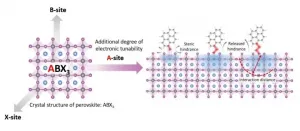(Press-News.org) Health care and education systems are two main pillars of a community's stability. How well and how quickly a community recovers following a natural disaster depends on the resilience of these essential social services.
New research from the Colorado State University Department of Civil and Environmental Engineering, published in Nature Scientific Reports, has found hospitals and schools are interdependent, suggesting their collective recovery must be considered in order to restore a community in the wake of disaster.
Because hospitals and schools are so integral to a community's well-being, Associate Professor Hussam Mahmoud and Ph.D. graduate student Emad Hassan wanted to determine the correlation between them to understand their overall influence on community recovery following extreme events. They found extensive direct and indirect relationships between health care and education, indicating recovery of one system relies on recovery of the other.
"This quantification has never been done before, so it was exciting to show that they depend on each other quite a bit," Mahmoud said. "Synchronizing the recovery might actually be very important if you want to optimize the overall recovery for the community."
Checking in on Centerville
A community's health care and education systems are complex on their own. Each has its own facilities and functions, requiring infrastructure, staff and supplies. To examine the intricate interactions between these systems, Hassan and Mahmoud comprehensively modeled hospitals, schools, community-built environments and even community members.
They based their study on a virtual community called Centerville, complete with physical, social and economic sectors and 50,000 individuals. The model was so detailed that the imaginary residents had their own roles within the community and were able to interact, learn, adapt and make decisions.
"The study, with this level of resolution, enabled us to capture interdependencies between hospitals and schools at the family and individual levels, which surprisingly showed that the two systems are significantly related and have an enormous role in community recovery after disasters," said Hassan, who was awarded a grant from the American Geophysical Union to present the research at the AGU Fall Meeting 2020.
Working within the NIST Center for Risk-Based Community Resilience Planning at CSU was helpful to understand the nature of these complicated systems from different perspectives, he said.
The study revealed the compounded role of hospitals and schools in communities' social stability and allowed the researchers to apply different strategies to these systems that might accelerate the whole community recovery after disasters.
Now the modeling approach Hassan and Mahmoud developed can be used to investigate other systems subjected to various kinds of disasters.
How stable is your community?
In response to the high level of interdependence they uncovered between health care and education systems, Hassan and Mahmoud created a social services stability index, so policymakers and community leaders can measure the social services stability within their own communities based on the functionality of hospitals and schools combined.
Mahmoud hopes this tool and deeper understanding of how these interdependent systems function will help communities recover faster, rather than wither, following disaster. He points to Butte County, California, where the population has dropped by 11,000 in the aftermath of the Camp Fire, which badly damaged the only local hospital.
"Without schools and hospitals, society cannot function properly," Mahmoud said.
INFORMATION:
UCLA materials scientists and colleagues have discovered that perovskites, a class of promising materials that could be used for low-cost, high-performance solar cells and LEDs, have a previously unutilized molecular component that can further tune the electronic property of perovskites.
Named after Russian mineralogist Lev Perovski, perovskite materials have a crystal-lattice structure of inorganic molecules like that of ceramics, along with organic molecules that are interlaced throughout. Up to now, these organic molecules appeared to only serve a structural function and could not directly contribute to perovskites' electronic performance.
Led by UCLA, a new study shows that when the organic molecules ...
Gene expression is a highly regulated process, which involves several steps. These include transcription of DNA instructions into RNA, removal of non-coding segments from the RNA message, and its subsequent translation into proteins. All these steps involve specific molecular machineries responsible for conducting each process with high accuracy. The Galej group, based at EMBL Grenoble, studies the structure and function of the RNA-protein complexes that are involved in the regulation of gene expression.
During transcription, genetic information contained in the DNA is used to create a precursor messenger RNA (pre-mRNA) thanks to the action of an enzyme, RNA Polymerase II. To maintain only the necessary coding segments ...
All life on earth evolved multiple layers and networks of ensuring survival upon catastrophic events. Even cells have their emergency plan: the heat shock response. Triggered by multiple stress stimuli such as heat, toxins, or radiation, this cellular safety program tries to prevent permanent damage to the organism. The response resembles an overall adopted "lockdown" strategy witnessed during the global corona virus pandemic. During a lockdown, only essential activities are permitted and resources were diverted towards measures ensuring minimizing the impact of a pandemic.
Under normal conditions, RNA polymerase II rushes down the DNA. At the correct places, the DNA is transcribed into mRNA, which is then translated into proteins. In a crisis, ...
SARS-CoV-2 mutations similar to those in the B1.1.7 UK variant could arise in cases of chronic infection, where treatment over an extended period can provide the virus multiple opportunities to evolve, say scientists.
Writing in Nature, a team led by Cambridge researchers report how they were able to observe SARS-CoV-2 mutating in the case of an immunocompromised patient treated with convalescent plasma. In particular, they saw the emergence of a key mutation also seen in the new variant that led to the UK being forced once again into strict lockdown, though there is no suggestion that the variant originated from this patient.
Using a synthetic version of the virus Spike protein created in the ...
Scientists at the Francis Crick Institute have found important structural similarities between SARS-CoV-2 and a pangolin coronavirus, suggesting that a pangolin coronavirus could infect humans.
While SARS-CoV-2 is thought to have evolved from a bat coronavirus, its exact evolutionary path is still a mystery. Uncovering its history is challenging as there are likely many undiscovered bat coronaviruses and, due to differences between bat coronaviruses and SARS-CoV-2, it is thought that the virus may have passed to humans via at least one other species.
In their study, published in Nature Communications, the scientists compared the structures of the spike proteins found on ...
A banking crisis is often seen as a self-fulfilling prophecy: The expectation of bank failure makes it happen. Picture people lining up to withdraw their money during the Great Depression or customers making a run on Britain's Northern Rock bank in 2007.
But a new paper co-authored by an MIT professor suggests we have been missing the bigger picture about banking crises. Yes, there are sometimes panics about banks that create self-reinforcing problems. But many banking crises are quieter: Even without customers panicking, banks can suffer losses serious enough to create subsequent economy-wide downturns.
"Panics are not needed for banking crises to have severe economic consequences," says Emil Verner, the MIT professor who helped lead the study. "But ...
Plastics made from crops such as maize or sugarcane instead of fossil fuels are generally considered sustainable. One reason is that plants bind CO2, which compensates for the carbon released into the atmosphere when plastics are disposed. However, there is a catch: With increasing demand for raw materials for bioplastic production, the areas under cultivation may not be sufficient. As a result, natural vegetation is often converted to agricultural land and forests are cut down. This in turn releases large amounts of CO2. The assumption that more bioplastics does not necessarily lead to more climate protection has now been confirmed by researchers at the University of Bonn ...
A study from the Center for Phage Technology, part of Texas A&M's College of Agriculture and Life Sciences and Texas A&M AgriLife Research, shows how the "hidden" genes in bacteriophages -- types of viruses that infect and destroy bacteria -- may be key to the development of a new class of antibiotics for human health.
The study has been published in Nature Communications and Current Science Daily, as well as featured in a recent Nature Research Microbiology Community blog post.
The need for new antibiotics
Antibiotic-resistant bacteria pose ...
Primeval forests are of great importance for biodiversity and global carbon and water cycling. The three-dimensional structure of forests plays an important role here because it influences processes of gas and energy exchange with the atmosphere, whilst also providing habitats for numerous species. An international research team led by the University of Göttingen has investigated the variety of different complex structures that can be found in the world's forests, as well as the factors that explain this diversity. The results have been published in Nature Communications.
The researchers investigated the structure of primeval ...
A vegan diet is more effective for weight loss than a Mediterranean diet, according to a groundbreaking new study that compared the diets head to head. The randomized crossover trial, which was END ...


